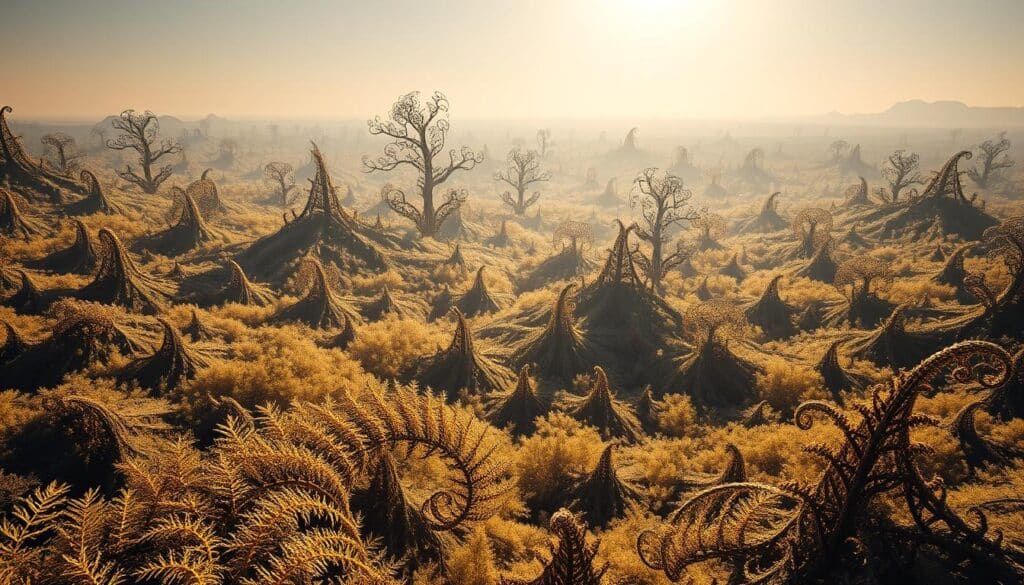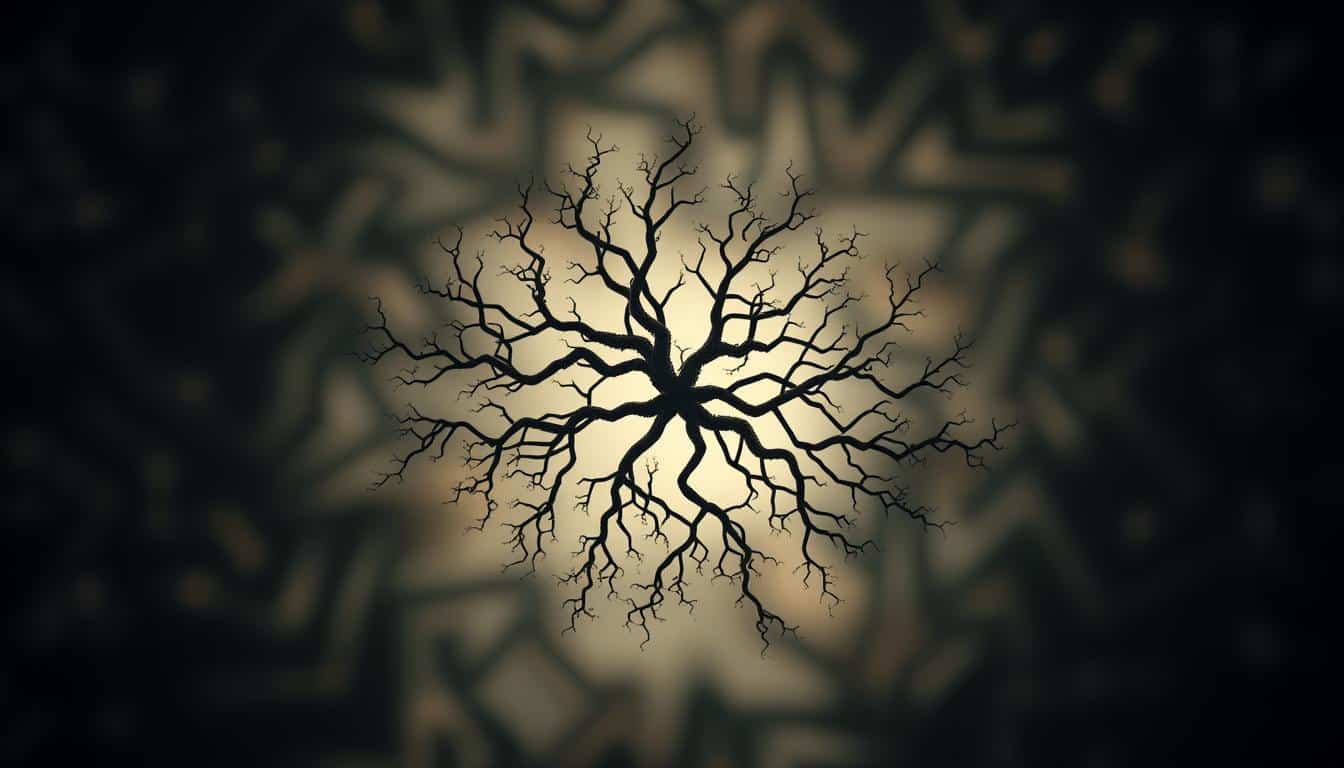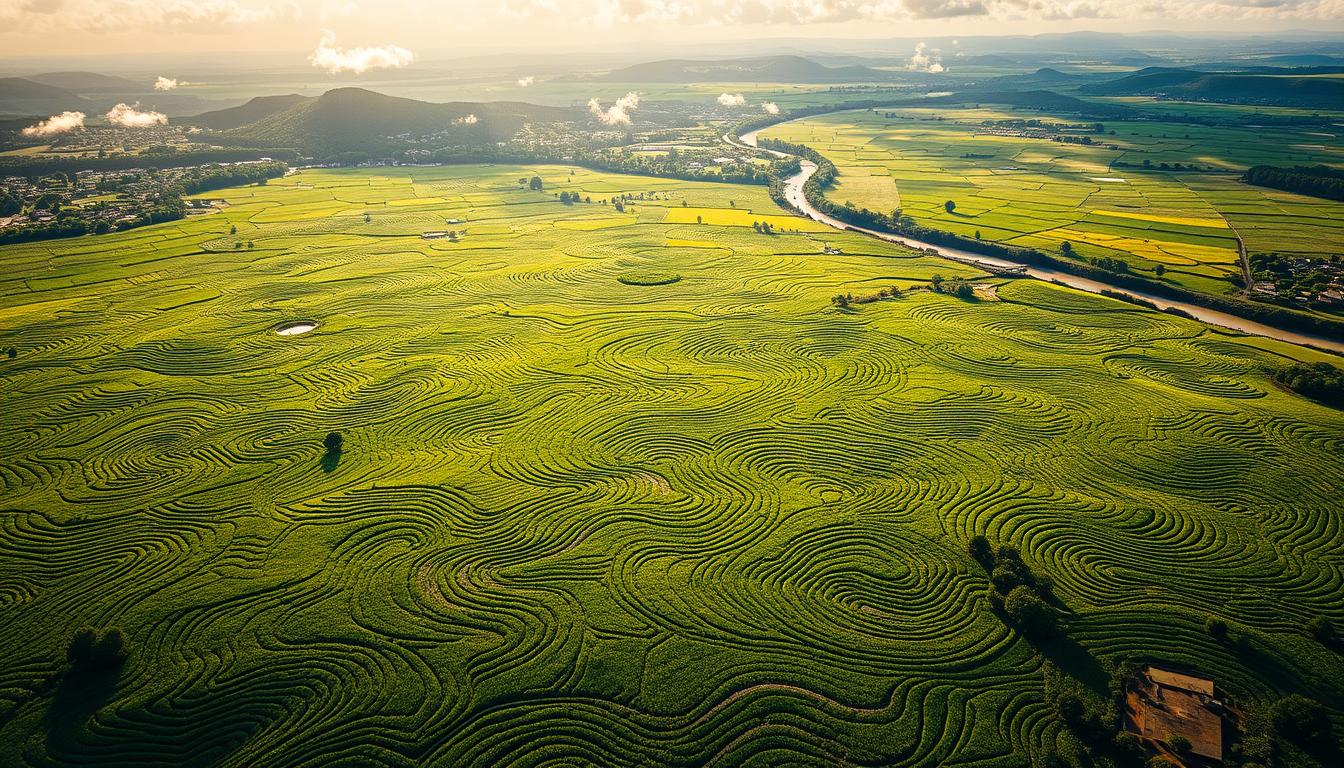The world around us is a canvas of stunning fractals in nature. Complexity emerges from simplicity through beautiful patterns and self-similar structures. This article invites you to dive into the essence of these intricate designs.
Fractal geometry shows up in everything from the delicate veins of leaves to the sprawling rivers. As we explore nature’s complexity, we uncover the importance of fractals. They help us understand our environment and the math that governs these mesmerizing formations.
The Essence of Fractals in Nature
Fractals show us the beauty in chaos. They are patterns that repeat in nature, like tree branches or clouds. Each part of a fractal looks like the whole thing. This shows how complex things can grow from simple rules.
Fractals help us see the order in nature. Scientists use them to study nature’s geometry. They show us the beauty and complexity around us. Through fractals, we learn to see the world’s elegance.

Understanding Fractals: Basics and Principles
Fractals let us peek into nature’s math, revealing patterns everywhere. They show us that shapes keep their form, no matter how close we look. This idea challenges old geometry by showing complex figures with simple rules.
Benoit Mandelbrot played a key role in fractal geometry. He talked about scale invariance – fractals look the same at any size. So, a rugged coastline seems alike, whether seen from high above or right from the beach.
Fractals also involve something called fractal dimension. It’s not like regular length or area. Instead, it tells us how fully a fractal fills space, pointing out shapes regular math can’t catch. By diving into fractals, we learn of nature’s way to craft detailed formations through math.
Fractals in Nature: Leaves, Rivers, Mountains, and Vascular Systems
Fractals are everywhere in nature, making the world around us beautifully complex. From the veins in leaves to the vast mountain ranges, they reveal nature’s patterns. These patterns help us understand how things grow, move, and change.
Leaves: The Geometry of Growth
Leaves show fractal patterns in their veins. This design helps them get nutrients and sunlight. It’s why plants can grow in many places.
Rivers: Meandering Patterns and Self-Similarity
Rivers wind in patterns that help carry water across the land. Their paths, shaped by the earth, support life around them. These patterns show how nature builds and maintains landscapes.
Mountains: Fractal Landscapes and Their Significance
Mountains are giants with surfaces full of complex patterns. Their shapes tell stories of the earth’s past. By studying these patterns, we learn more about our planet.
Vascular Systems: Branching Patterns in Biological Organisms
The networks in our bodies are examples of fractals. They transport what cells need to live. This complex system shows how life itself is built on patterns.
The Mathematical Foundation of Fractals
Fractals are complex and beautiful, rooted in specific math. They use equations to create detailed patterns and shapes. The Mandelbrot Set is a famous example, showing amazing visuals through repeated calculations.
Fractal dimensions are key to understanding these patterns. Unlike simple shapes, fractal dimensions are not whole numbers. They show how complex a fractal shape is, helping mathematicians study them better.
Fractal math has real-world uses in many areas like physics, biology, and environmental science. Knowing about fractals helps scientists study nature’s patterns. This connects abstract math to the real world in useful ways.
Historical Perspective: The Journey of Fractal Discovery
The journey into fractal geometry is both rich and complex. It has seen major contributions that have shaped its growth. Benoit Mandelbrot’s work in the 1970s is very notable. He introduced key ideas and terms that are vital today. His approach offered a fresh way to look at complex systems. This helped us understand natural phenomena better.
Benoit Mandelbrot: The Father of Fractal Geometry
Benoit Mandelbrot changed the way we see patterns in nature through fractal geometry. He looked at shapes and structures that don’t fit normal geometric rules. His famous Mandelbrot set fascinated mathematicians, artists, and the public alike. It showed the beauty in finding fractals. His work sparked more research into nature’s complexities, marking him as a key figure in this field.
The Impact of Chaos Theory on Fractal Studies
Chaos theory has deeply impacted how we understand fractals, linking the two areas closely. It lets researchers see and study things once thought to be random. The mix of chaos theory and fractal geometry has led to a scientific breakthrough. It helps experts find order in what seems chaotic. This blend of ideas has pushed forward math studies and revealed nature’s complexity.
The Role of Technology in Fractal Research
Technology has greatly changed fractal research, thanks to AI and new tools. Researchers now use advanced methods for more accurate fractal analysis. This change helps scientists study complex patterns in biology, ecology, and city planning.
AI helps simulate complex models that were hard to analyze before. For example, smart algorithms find hidden links in fractals. This helps us understand natural wonders better. Graph-based Retrieval Augmented Generation (GraphRAG) is a key innovation. It organizes big data to improve studies on fractals.
As tools get better, we can do more with fractal research. Better data processing lets researchers explore deeper. This makes it easier to link discoveries in exciting new ways. Thanks to technology, fractal research has a bright future ahead.
Applications of Fractal Geometry Across Disciplines
Fractal geometry has changed many fields, starting a new era of insight and analysis. It’s seen in areas like medicine, ecology, and cosmology, showing its wide use and value in research today. Different fields use fractals’ unique features to solve complex issues.
Fractals in Medicine: Understanding Biological Structures
In medicine, fractals help reveal the complex designs of biological structures. Scientists study patterns in blood vessels and lung shapes using fractals. This method improves disease diagnosis, leading to better health outcomes.
Fractals in Ecology: Studying Ecosystem Patterns
Ecologists use fractal analysis to understand ecosystem patterns. They look at nature’s repeating patterns to foresee changes in ecosystems, especially due to climate change. This insight helps with conservation and managing natural resources.
Fractals in Cosmology: Analyzing the Universe’s Structure
Cosmology uses fractals to delve into the universe’s structure. This includes studying galaxies and dark matter’s spread through fractal principles. Such research deepens our cosmic knowledge and questions current astrophysics theories.
The Intersection of Fractal Art and Nature
Fractal art is a beautiful mix of math and creativity. It shows the detailed patterns of nature in a visual way. By turning complex equations into art, it highlights the beauty of natural patterns.
Artists use the repeating patterns in fractals to show life’s deep principles. This art teaches us about nature’s beauty and the complex math behind it. Many artists use modern technology to blend science with their artistry.
This art form celebrates the mix of chaos and order in nature. Each artwork connects with people, making them think about the fractal patterns around us. These patterns are part of art and our everyday life.
The Future of Fractal Research: AI and Beyond
Fractal research’s future is bright as tech advancements open new possibilities. AI helps researchers study complex fractal patterns more efficiently. This leads to discoveries that were once thought impossible. Using quantum computing, researchers can now explore complex fractal geometries. These geometries are essential in understanding many natural phenomena.
Soon, we could see fractals used in different areas. Urban planners might use fractal ideas to make cities more sustainable, mimicking nature’s efficiencies. Fractal encryption could also improve data security, keeping sensitive information safe.
The future of fractal research will deeply integrate technology. This will change how we see natural patterns. It promises to enhance our scientific knowledge and inspire creativity in many fields.
Fractal Patterns in Everyday Life: Recognizing the Beauty Around Us
Fractal patterns are part of our daily life, often unseen but deeply impactful. They define nature and push forward urban and sustainable designs. By noticing fractals, we see the beauty in nature and human creations.
Fractal Aesthetics: The Appeal of Complex Patterns
Fractals catch our eye with their complex, repeating shapes. We see them in tree branches and coastlines. This beauty inspires artists and designers, leading to visually stunning designs that feel natural.
Fractals in Urban Design: Creating Sustainable Cities
Fractal principles help make cities sustainable. They allow for better resource use and more enjoyable urban spaces. Buildings and public areas with fractal designs use land and energy efficiently. This makes cities better for the environment and more beautiful.
Conclusion
This exploration shows fractals are key at nature and math’s crossroads. They’re seen in things like leaves and rivers. They’re also in city designs and art. Fractals help us grasp our complex world.
Seeing these patterns grows our knowledge of nature. It also boosts studies in different scientific areas.
Fractals’ impact goes beyond their looks. They link areas like medicine, ecology, and the stars. This shows a strong bond between math and nature’s ways.
Appreciating fractals’ designs opens doors for new discoveries. These may explain the universe and our creativity.
As research moves forward, fractal studies with tech and AI can bring new breakthroughs. Understanding these math rules better could reveal more about our world. This highlights fractals’ lasting importance in nature and human achievements.



